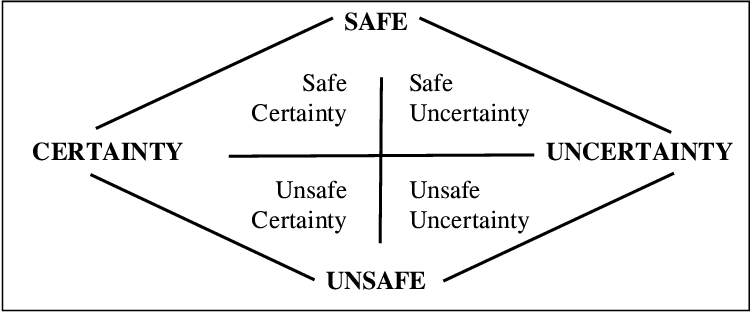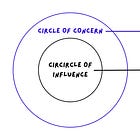Low morale in your team? focus on Safety
- Sergio Visinoni from Sudo Make Me a CTO <makemeacto@substack.com>
- Hidden Recipient <hidden@emailshot.io>
Hi, 👋 Sergio here! Welcome to another free post from the Sudo Make Me a CTO newsletter. If you prefer to read this post online, just click the article title. As this is a free newsletter, I do immensely appreciate likes, shares and comments. That's what helps other readers discover it! Low morale in your team? focus on SafetyWhen I work with leaders who are facing situations of low morale in their team, I usually introduce them to a powerful tool to understand the difference between Certainty and SafetyToday's post is inspired by a conversation I had with one of my clients recently. This person is an Engineering Manager facing a situation with their team showing signs of low morale and increased feelings of uncertainty. With about 50K tech layoffs since the beginning of the year, more and more workers in the industry are developing anxiety and might not be fully prepared for the transition from an employee-led market to an employer-led market. This post is not focused on analyzing the context and the situation, as you can find a lot of them using your favorite search tool, be it GenAI-powered or old-fashioned. I'll focus instead on providing recommendations for managers and leaders who are facing such situations with people in their teams. If you find this article useful, I would love to hear from you in the comments section. Let's dive into it! 🫵🏼 It All Starts With YourselfWhenever a leader tells me that they are facing a situation of lack of motivation in their team, I always suggest we ignore the team for a second and focus on themselves instead. I ask them to reflect on themselves and their concerns, doubts, and feelings. The reason for that is very simple. Have you ever wondered why in airplanes you are instructed to first put on your breathing mask before trying to help others? Because if you're running out of oxygen yourself, you can't help anyone else with their oxygen mask! Something very similar happens in the leadership context. You can only motivate people if you are motivated and secure yourself as their leader. How could you sell them a vision of the future that you don't believe in? This is why I invite the leader to take the required time to reflect on this question first. After reflection, they will largely fall into one of these two categories. Either they fully believe in what the company is doing, its strategy and direction, or they don't. If they fall into the first category, I then move the conversation to how to help their team as well. If not, we spend more time focusing on getting a better sense of the leader's situation. Ultimately the question I want to answer is: is there a chance to turn their perspective around? As a third-party consultant, I can offer an unbiased view on whether or not they should roll up their sleeves and build the future they want at their current company, or start looking for a new job. Sometimes the conversation ends up exactly there, with the two of us concluding that they will be better off focusing energy in the search for a new job. Most of the time though we realize they still have a lot of agency where they are, and I help them surface meaningful actions they can take to improve the situation. Once they have regained a healthy level of optimism for their situation in the firm, then we turn our attention to the team. ↩️ Only now, turn your attention to the teamOnce the leader is in a good place, it's time to work on the team. Or rather, with them. One tool I like to introduce at this point is the model originally introduced by Barry Mason - Barry, not Perry! - in the early 90s. In his paper titled Towards Positions of Safe Uncertainty, he introduces the concept of. "Safe Uncertainty”. To be completely honest, I discovered the paper only recently, as I was originally introduced to its key concepts concept by a coach I worked with in 2017. The company I was working at was going through some major transformations, and the coach guided us through an exercise based on the findings of that original paper, but without going through the whole theory. The good thing is that the introduction I got was very practical and actionable. This is exactly the approach I take when introducing this tool to my clients, and how I'll do it in this article. If you still want to go ahead and read the full paper, be my guest! ⚖️ Certainty vs SafetyThe gist of this model and approach starts from clarifying 2 concepts that we often confuse in the context of life, and work specifically: Certainty and Safety. Let's start with some definitions from the Cambridge Dictionary:
In the model put forward by Mason, he draws these concepts as two dimensions on a cartesian system, as you can see below: And here comes the powerful insight: certainty is a mere illusion. Nobody has the power to predict the future. Without sounding too fatalistic, anyone could be hit by the proverbial bus tomorrow. By the way, have you ever wondered why we say hit by a bus rather than a car, a truck, or a scooter? It might have to do with mass and inertia, but I'm digressing. Life is filled with unpredictable events: wars, pandemics, financial crises, massive layoffs, etc. Focusing your energy on trying to predict the future will not take you very far. As leaders, we sometimes fall into the trap of trying to reassure people with confident predictions, filled with “trust me”, and “I know what's going to happen” statements when in reality we can't predict the future any better than them. What we should focus on instead is to help bring people toward a state of “Safe Uncertainty”. This means that instead of trying to sell them predictions, we should help them feel safer. Even better, build safety. In the context of employees in tech companies, this usually boils down to shifting their focus back into two macro areas:
For the attentive readers, this might remind you of what I wrote about in last week's article on the differences between proactive and victim approaches. If that's the case, you'd be right. If you haven't read it yet, follow the link below, and don't forget to come back here afterward! This is yet another example where focusing on what is in one's ability to control and influence is always the most effective approach. Though these mechanisms seem to work very well, don't forget you're dealing with people. Keep in mind that you should leave them enough space to express their concerns and fears, and never dismiss them as not important or not relevant. They might not be important to you, but they are probably very important to them. Give room for expressing their thoughts. Acknowledge them. Then move on with refocusing their attention on what they can do something about. 🏁 ConclusionsIn today's shorter-than-usual article, we looked at how leaders can deal with situations of low morale and anxiety in their teams. When I work with clients that are facing such challenges, I generally offer the following approach:
I have found this approach simple yet very effective on multiple occasions. I hope it will be as useful to you as it has been to me. See you next week! Sudo Make Me a CTO is a free newsletter edited by Sergio Visinoni. If you found this post insightful, please share it with your network using the link below. If you or your company need help with one of the topics I talk about in my newsletter, feel free to visit my website where you can schedule a free 30 minutes discovery call. I'd be delighted to investigate opportunities for collaboration! |
Similar newsletters
There are other similar shared emails that you might be interested in:

